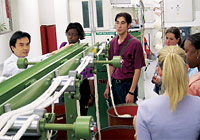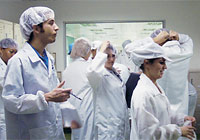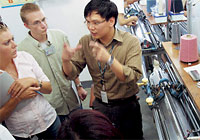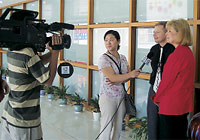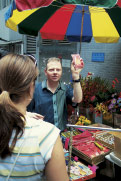 |
|||||||||||||||||

The Hong Kong/China Connection |
However, some 108 UNT merchandising and marketing students know about overseas product sourcing from personal experience, making them more desirable to employers in wholesale or retail companies when they graduate. The students in UNT’s intensive three-week program — which is sandwiched within regular summer school classes for which they can earn college credit — travel to Hong Kong and China to learn their fields from the inside out. Beyond academic
“Our overarching purpose is to foster learning and living experiences for our students,” explains Lou Pelton, associate professor of marketing and logistics and a faculty sponsor of the program along with Dee Knight (’95 M.S.), assistant professor of merchandising. “It goes way beyond academic,” Pelton says. “Cultural immersion is another goal.” Now in its fourth year, the Hong Kong/China study abroad program has already become the largest of UNT’s approximately 20 faculty-led programs and the only one in Asia. Students in the program (38 this summer) witness the apparel supply chain from fiber manufacture through shipment of finished garments. They learn about quality testing, merchandising and marketing of products and meet with factory managers, business executives and government officials about doing business in China. Key contacts Morgan Lee, who will graduate in August, learned that “the world is not one-dimensional. It’s global now. … You can do business just as easily overseas and with 10 times the opportunities.”
Lee was among 30 students who traveled in the summer of 2004 to southern China’s Pearl River Delta, chosen because it is “the fastest growing economic region in the world,” Pelton says. There they visited production factories for retailers such as J.C. Penney Co., Target and Fossil. The visits were set up in advance through the professors’ Dallas-area corporate contacts, which are a key to the program. “Schools just can’t go into factories on our own,” Knight says. “We couldn’t get in without them.”
The program originated in 2003 when the professors were working on an international research project. When Pelton asked Knight if she was interested in taking merchandising students to Asia, she responded enthusiastically. “Everyone is sourcing apparel in Asia today. Our students now can tell prospective employers that they have been in Asian factories,” Knight says. Passing on the savings Pelton notes that the program has “built a critical mass of students and an unprecedented level of business relationships” very quickly. He attributes its popularity to general interest in China’s dynamic southern region, to the program’s leveraging of Dallas business contacts that smooth the way and to the reasonable price.
Unlike many study abroad programs, the Hong Kong/China program doesn’t contract with outside, for-profit companies to make arrangements. The two professors personally set up everything and pass on the savings. Not that the program is inexpensive. This summer’s trip costs $3,495 per student. That includes not only air fare and factory tours, but also hotels, breakfast buffets, catered meals, a ground-transport pass in Hong Kong and a full-day tour of Macao. An extensive orientation DVD shows students how to prepare for their trip and clues them in to Chinese cultural basics. Learning experience
Before and after the trip, the students attend either one or two of the three marketing and merchandising classes connected with the course. Staci Judice, who went in 2004, believes the trip was worth every cent. “It didn’t cost all that much, given where we went, what we saw and experienced. I saw it as both a learning experience and an adventure. I thought, ‘I’ll be taking classes in a foreign country. How cool is that?’”
Even while traveling, Judice and the other students had to work on academic projects. Knight had students compare Hong Kong department stores to each other and to U.S. counterparts, considering such factors as customer experience, merchandising strategies and store ambience. Pelton’s academic project required the students to put together a market entry strategy for a product being either imported or exported through Hong Kong. He says the students came to the understanding that it’s one thing to read about cultures and another thing entirely to experience them.
“One of the learning outcomes is that they see the real-world impact of cultural differences on marketing and merchandising strategies.” Cultural effects For example, they saw that the small size and crowded population of Hong Kong forces entirely different consumption patterns. Homes — typically apartments — are only about 20 percent of the size of the average U.S. apartment, Pelton points out. That means people tend to shop for food daily, give away older clothing when they purchase new garments and buy smaller furniture because they simply don’t have room to do otherwise.
In China, the students witnessed poverty among people who work hard to advance. They learned that factory workers frequently live in compounds on the factory grounds, with little time for leisure and even less personal space than in Hong Kong for possessions. Learning about the government’s policy of one child per family, they encountered what Pelton calls “the generation without cousins” and discovered how having only one child influences parental buying habits as well as how merchandise is promoted. Students keep a journal about their experiences on the trip. Knight quotes one young woman as writing, “It challenged the way I think, the things I’ve always believed, and in the end, I realized I had changed — I guess that’s what learning is all about.” Adds Knight, “She got it. That is what learning is all about.” Hong Kong/China photos by Lynn Brandon, associate professor of merchandising
|
||||||||||||||||||||||||||||||||||||||||||||||||||||||||||||||||||||||||||||||||||||||||||||||||||||||||||||||||


